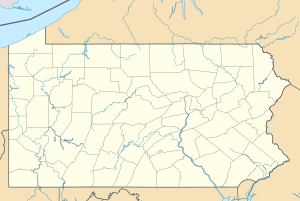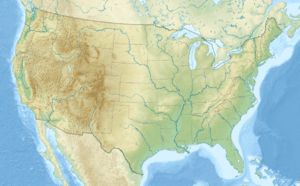McDonald Run (Slippery Rock Creek tributary) facts for kids
Quick facts for kids McDonald Run |
|
|---|---|
|
Location of McDonald Run mouth
|
|
| Other name(s) | Tributary to Slippery Rock Creek |
| Country | United States |
| State | Pennsylvania |
| County | Butler |
| Physical characteristics | |
| Main source | divide between McDonald Run and McMurray Run Forestville, Pennsylvania 1,330 ft (410 m) 41°06′29″N 080°00′40″W / 41.10806°N 80.01111°W |
| River mouth | Slippery Rock Creek about 1 mile south of Branchton, Pennsylvania 1,160 ft (350 m) 41°03′39″N 079°59′16″W / 41.06083°N 79.98778°W |
| Length | 3.07 mi (4.94 km) |
| Basin features | |
| Progression | south |
| River system | Beaver River |
| Basin size | 4.02 square miles (10.4 km2) |
| Tributaries |
|
McDonald Run is a small stream, often called a "run," located in Butler County, Pennsylvania, in the United States. It flows for about 3.07 miles (4.94 kilometers). This stream is important because it feeds into a larger waterway called Slippery Rock Creek. McDonald Run helps carry water from the land into bigger rivers, playing a part in the natural water cycle.
Contents
Discovering McDonald Run
McDonald Run is a natural stream that flows through a part of Pennsylvania. It's not a huge river, but it's an important part of the local environment. Understanding small streams like McDonald Run helps us learn about how water moves across the land and connects to larger water systems.
Where Does McDonald Run Begin?
Every stream has a starting point, and for McDonald Run, it begins near a place called Forestville in Butler County, Pennsylvania. This area is about 1,330 feet (405 meters) above sea level. The water that forms McDonald Run comes from rain and melting snow that collects on the land. It then starts to flow downhill, forming tiny channels that grow into the stream.
The Journey of the Stream
Once it begins, McDonald Run flows generally towards the south. As it travels, it picks up more water from smaller, unnamed streams that join it along the way. These smaller streams are called "tributaries." Imagine them as little helpers, adding their water to the main stream. The land around the stream, which collects water for it, is called its "basin." McDonald Run's basin covers about 4.02 square miles (10.4 square kilometers).
Where Does McDonald Run End?
After its journey of about 3 miles, McDonald Run reaches its end. It flows into Slippery Rock Creek, which is a much larger stream. This meeting point is located about 1 mile south of a place called Branchton, Pennsylvania. At this point, McDonald Run is about 1,160 feet (354 meters) above sea level. The water from McDonald Run then becomes part of Slippery Rock Creek, which eventually flows into the Beaver River and then into the Ohio River.
Why Are Small Streams Important?
Even though McDonald Run is small, streams like it are very important for many reasons:
- Water Flow: They help move water from higher ground to lower ground, eventually reaching larger rivers and even oceans. This is a key part of the Earth's water cycle.
- Habitats: Small streams provide homes for many plants and animals. Fish, insects, and other creatures depend on the clean water and the environment around the stream to live and grow.
- Natural Beauty: Streams add to the natural beauty of the landscape. They can be peaceful places for people to visit and enjoy nature.
- Water Quality: The health of small streams affects the health of larger rivers. If a small stream is polluted, that pollution can travel downstream and harm bigger waterways.
Fun Facts About McDonald Run
- McDonald Run is a "tributary," which means it's a stream that flows into a larger stream or river.
- The stream flows downhill, losing about 170 feet (52 meters) in elevation from its start to its end.
- On average, about 6.07 cubic feet (0.17 cubic meters) of water flow out of McDonald Run into Slippery Rock Creek every second. That's like filling a small bathtub with water every second!



